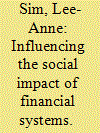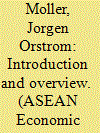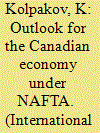|
|
|
Sort Order |
|
|
|
Items / Page
|
|
|
|
|
|
|
| Srl | Item |
| 1 |
ID:
138418


|
|
|
|
|
| Summary/Abstract |
There are more international migrants today than at any other time in history, and at the same time, the globalization of supply chains and financial systems has spawned vast and once-unimagined networks of transit, communication, and distribution. This means people are moving in ways that are not always captured in accepted international migration statistics and to countries that are ill-equipped to develop or implement a national immigration policy. The confluence of these factors has contributed to a globalization of ‘undocumentedness,’ and yet, the global conversation about undocumentedness still orients itself to the United States and Europe. A quick survey of extant literature on undocumentedness, international migration, and informal labor points to a significant gap in scholarship on the causes and consequences of permanent and growing cross-border undocumented migration between developing countries, and as a global phenomenon. Research on undocumented immigrant communities in the West frequently focuses on social justice or national security concerns in a single place with a large undocumented population, rather than placing the emergence of those communities within the broader context of how international migration has changed. For example, undocumented migrants in the West are likely to have been undocumented migrants in developing or middle-income countries as well. Migrant networks often span many countries at once. This article will position undocumentedness as a global phenomenon, examining how economic globalization has contributed to a globalization of low- to middle-income migration to regional powers with limited-to-no migration management strategy or infrastructure. It will also consider some of the challenges undocumented migration poses in countries dealing with endemic poverty, massive internal migration, and structural race/caste/tribal fissures. Finally, it will consider what citizenship and belonging mean in this new global era.
|
|
|
|
|
|
|
|
|
|
|
|
|
|
|
|
| 2 |
ID:
171206


|
|
|
|
|
| Summary/Abstract |
The social impact of the global financial crisis brought global and domestic financial systems into public focus. While over the last ten years governments have introduced a range of regulatory reforms, there are still low levels of public trust in financial sectors, and academics continue to express their concerns about financial systems and their desire for more influence. This is particularly the case for those framing their evaluation of the quality of financial systems in terms of social values. This article offers those seeking more influence over the social values of financial systems, a fresh perspective on their available strategic options for influencing outcomes. It argues that they should consider strategies aimed at making allies of financial sectors and regulators in influencing change. The main advantage of these alliance strategies is that they address key constraints to influence, as identified in existing scholarship, which are difficult to relax because they are tied to features inherent in financial systems. By addressing these constraints, alliance strategies could increase the likelihood that financial system outcomes align more closely with their preferred social values.
|
|
|
|
|
|
|
|
|
|
|
|
|
|
|
|
| 3 |
ID:
083050


|
|
|
|
|
| Publication |
2008.
|
| Summary/Abstract |
From the 1950s up to the early 1990s the All-India data show an ever-declining share of informal credit in the total outstanding debt of rural households. Contemporaneous micro-level studies, using more qualitative research methodologies, provide evidence that questions the strength of this trend, and more recent All-India credit surveys show, first, a levelling, and then a rise, in the share of rural informal credit in 1990/91 and 2000/01, respectively. By reference to findings of a study of village moneylenders in Rajasthan, the paper notes lessons to be drawn. First, informal financial agents have not disappeared from the rural financial landscape in India. Second, formal-sector financial institutions can learn much about rural financial service needs from the financial products and processes of their informal counterparts. Third, a national survey of informal agents, similar to that of the 1921 Census survey of indigenous bankers and moneylenders, would provide valuable pointers towards policy options for the sector. A recent Reserve Bank of India Report on Moneylender Legislation not only explores incentive mechanisms to better ensure fair practice, but also proposes provision for a new category of loan providers that would explicitly link the rural informal and formal financial sectors
|
|
|
|
|
|
|
|
|
|
|
|
|
|
|
|
| 4 |
ID:
065238


|
|
|
| 5 |
ID:
121861


|
|
|
|
|
| Publication |
2013.
|
| Summary/Abstract |
The global debt crisis will keep the world economy in a straitjacket for some time and reinforce the shift from established economic powers to Asia. Debt needs to be repaid in the form of lower consumption and the deleveraging process for the G-3 (the United States, the eurozone, and Japan, who have reached an unprecedented level of debt), still has a long way to go. The United States opted for fiscal and monetary stimulus, the eurozone chose austerity, and Japan after some hesitation started to pump money into the economy. It remains to be seen whether the divergence in policies will constitute a barrier for a global recovery. Southeast Asia has so far managed quite well because the lesson was learned in 1997-98 and signs of strong borrowing have been detected only recently. The main problem seems to be how to plug into a new and amended global financial system that has emerged in response to flaws that were identified when the crisis struck.
|
|
|
|
|
|
|
|
|
|
|
|
|
|
|
|
| 6 |
ID:
131837


|
|
|
|
|
| Publication |
2014.
|
| Summary/Abstract |
CANADA was among the few developed market countries whose banking and financial systems did not experience any significant disturbances in the face of global economic instability.1
Having started in November 2008, the economic downturn was shortlived.
Six months later, GDP growth resumed and in mid-2010 its volume exceeded the pre-crisis maximum.2
In the third quarter of 2012, Canada's GDP reached 1.765 trillion US dollars.
According to a number of international experts, Canada is the most stable of the 20 countries with the largest economic potential.
The conditions of doing business in Canada, and its investment attractiveness are estimated very highly. More than that, according to such an authoritative magazine as Forbes, Canada was recognized in 2011-2012 as the world's best place for business due to low levels of taxes and red tape.3
|
|
|
|
|
|
|
|
|
|
|
|
|
|
|
|
|
|
|
|
|